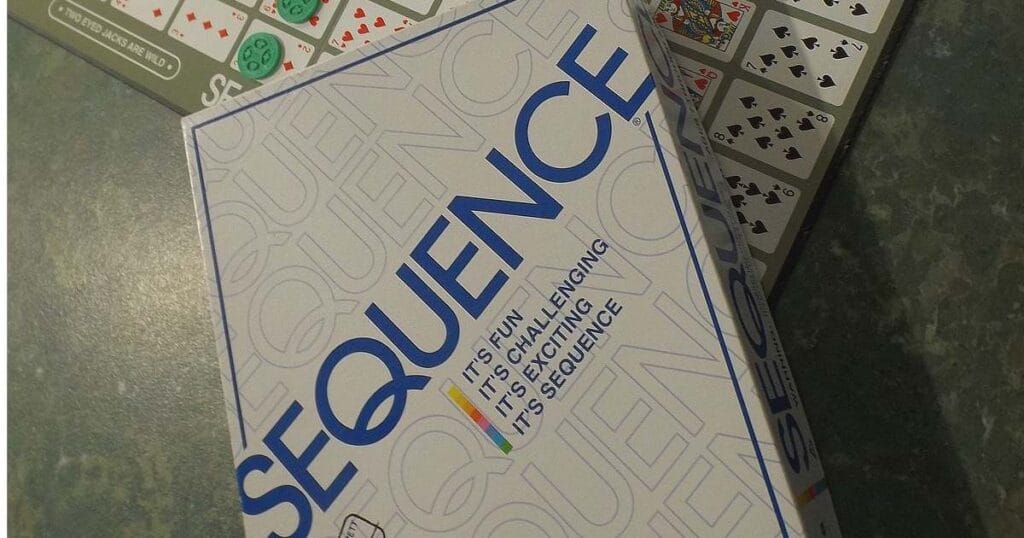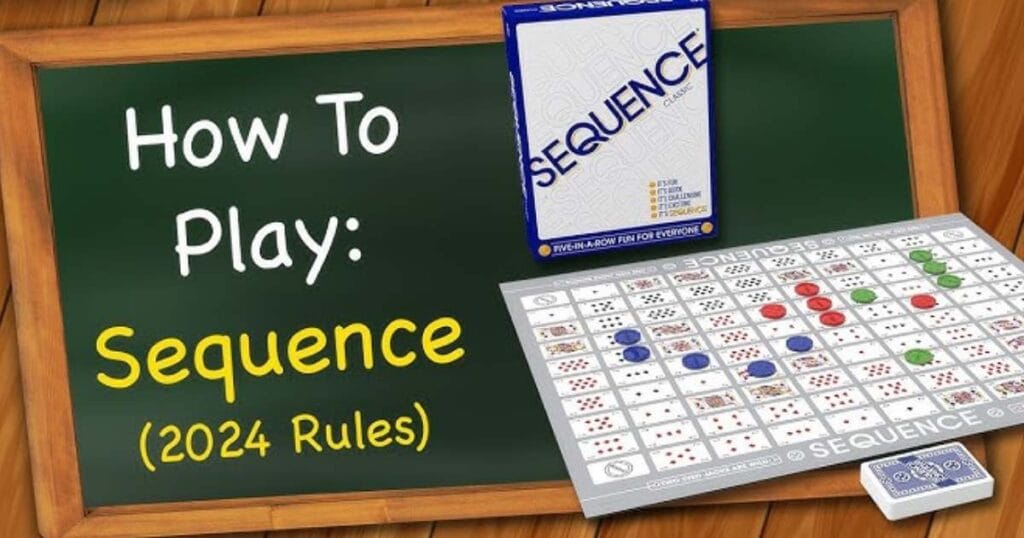Sequence Rules: is a fast-paced, strategic card game that pits players against each other in a race to create lines of chips on the game board. It’s a game of skill, luck, and a bit of bluffing. Whether you’re a seasoned card game enthusiast or a casual player, Sequence offers an engaging and competitive experience.
Table of Contents
Objective of the Sequence Rules

The primary goal of Sequence is to create a line of five chips of your color in a row, either horizontally, vertically, or diagonally. This line is known as a “Sequence.” For two-player or two-team games, you need to create two Sequences to win. In a three-player or three-team game, only one Sequence is required for victory.
- Game Components
- A game board with a grid of playing spaces
- Two standard decks of playing cards
- 108 marker chips (three colors)
- Instructions
Setup Sequence Rules
- Shuffle the decks: Combine the two decks and shuffle them thoroughly.
- Deal cards: Deal each player five cards.
- Place marker chips: Choose two colors of chips and place them near the game board. The third color is set aside.
- Determine the starting player: The player with the lowest card dealt starts the game. Aces are high.
Gameplay
- Playing a card: On your turn, play one card from your hand face-up on the table.
- Placing a chip: After playing a card, place one of your marker chips on a matching space on the game board. For example, if you play a Queen of Hearts, you can place a chip on any Queen of Hearts space on the board.
- Special cards:
- Jacks: A one-eyed Jack allows you to remove one opponent’s chip from the board. A two-eyed Jack lets you place a chip on any open space on the board, regardless of the card played.
- Jokers: A Joker can be used as any card.
- Blocking opponents: If a space is already occupied by an opponent’s chip, you can’t place your chip there. However, if you play a card that matches the space, you can “jump” over the opponent’s chip and place one of your chips on the next available space in the same row or column.
- Creating a Sequence: When you have five of your chips in a row (horizontally, vertically, or diagonally), you’ve created a Sequence. This includes using the four corner spaces as wildcards.
- Removing a chip: Once you’ve created a Sequence, you can remove one of your opponent’s chips from the board.
- Drawing a card: After playing a card and placing a chip, draw a new card from the deck to replenish your hand.
Winning the Game in Sequence Rules

The first player or team to achieve the required number of Sequences wins the game.
Additional Rules and Tips
- Team Play: Sequence can be played with teams. Divide players into teams and work together to create Sequences.
- Strategy: Planning your moves is crucial. Consider your opponents’ positions and potential moves.
- Bluffing: Sometimes, playing a card that doesn’t immediately benefit you can mislead opponents.
- Protecting your chips: Once you’ve placed a chip, it’s essential to protect it from being removed by opponents.
Sequence is a game that offers endless possibilities and strategic depth. With practice, you’ll develop your own unique playing style and increase your chances of victory. So gather your friends, shuffle the cards, and enjoy the excitement of Sequence!
Mastering the Art of Sequence Rules
Now that you have a solid grasp of the basic rules of Sequence, let’s delve deeper into some advanced strategies and tips to elevate your gameplay.
Strategic Chip Placement
- Centralization: Aim to place your chips in the center of the board. This increases your chances of creating multiple potential Sequences.
- Defense: Protect your chips by placing them strategically to block your opponents’ potential lines.
- Offense: Focus on creating opportunities for your own Sequences while simultaneously disrupting your opponents’ plans.
Card Management
- Hand Evaluation: Constantly assess the cards in your hand and prioritize those that can help you create Sequences or block your opponents.
- Discarding Wisely: Don’t be afraid to discard cards that don’t benefit you immediately. Sometimes, holding onto a weak hand can hinder your progress.
- Counting Cards: Keep track of the cards that have been played to anticipate your opponents’ moves and plan accordingly.
Advanced Tactics
- The Jump: Mastering the jump move can be a game-changer. Use it to create unexpected Sequences or block your opponents’ progress.
- The Block: Strategically place chips to prevent your opponents from forming Sequences.
- The Sacrifice: Sometimes, it’s necessary to sacrifice a chip to create a more advantageous position.
- Bluffing: Misleading your opponents about your intentions can be a powerful tool.
Common Mistakes to Avoid
- Overconfidence: Don’t become complacent, even if you’re ahead. The game can change quickly.
- Ignoring Opponents: Focus on your own game, but also keep an eye on your opponents’ moves.
- Rushing: Take your time to analyze the board and make informed decisions.
Variations and Challenges
To keep the game exciting, you can introduce variations to the standard rules:
- Double Sequences: Require players to create two Sequences to win, even in two-player games.
- Chip Removal: Allow players to remove any opponent’s chip, not just those adjacent to their Sequence.
- Team Play: Divide players into teams and work together to create Sequences.
- Time Limit: Set a time limit for each turn to add an element of pressure.
Conclusion
Sequence is a game that rewards strategic thinking and adaptability. By implementing these advanced tips and experimenting with different strategies, you can significantly improve your gameplay and increase your chances of victory. Remember, practice makes perfect, so keep playing and enjoy the challenge!
Read Also:







